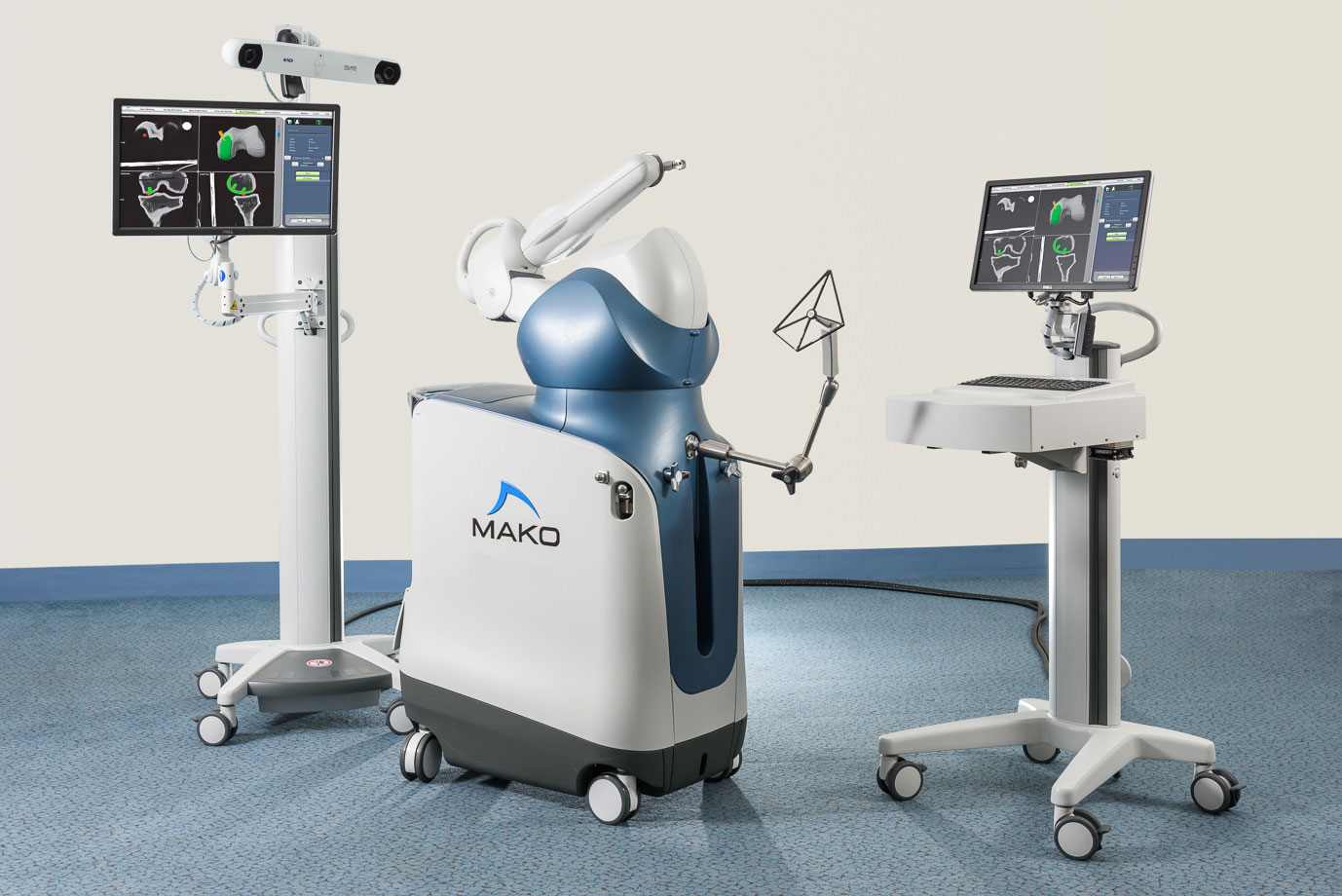Mako Robotic-Arm Assisted Surgery
The Mako Robotic-Arm Assisted Technology & Surgery makes possible highly predictable surgical experiences when performing hip and knee joint replacement surgery. The Mako System provides CT scan derived, patient-specific 3D modeling enabling accurate planning of implant size, orientation and alignment. The current Mako System product offering includes Partial Knee, Total Hip and Total Knee surgical applications.
Mako Robotic-Arm Assisted Technology was acquired by Stryker in December 2013 with a goal of transforming orthopaedic surgery by combining Stryker’s market-leading implants with Mako’s proprietary robotic-arm technology.
About the Mako
The Mako System provides dynamic joint balancing by allowing the orthopedic surgeon to make intra-operative adjustments in order to optimize implant placement. The robotic-arm does NOT make decisions on its own or move without the surgeon guiding the robotic-arm.
Patient-specific pre-operative planning enables more accurate implant positioning. The surgeon can modify the plan if necessary based on the intra-operative data to virtually balance the joint and achieve individualized placement.
Mako Surgery
Prior to surgery, a CT scan of the hip or knee joint is taken to generate a 3D virtual model of the patient’s unique anatomy. The 3D model helps the doctor see areas they can’t typically see with an x-ray alone. This additional information helps your doctor determine the optimal size, placement and positioning of the implant or removal of bone and cartilage.
The Mako System provides real-time data to your surgeon throughout the entire procedure and the surgeon can adjust the surgical plan if desired. The Mako System provides the surgeon a virtual boundary with real tactile resistance to keep the surgeon within the boundaries defined in the surgical plan.
The surgeon guides Mako’s robotic arm to remove the arthritic bone and cartilage from the joint. The Mako robotic-arm guides the implant at the specific angle ensuring the proper placement and alignment of the implant.
How Does the Mako System Work?
A CT scan of the patient’s diseased hip or knee joint area is uploaded into the Mako System software, which creates a 3D model. The orthpedic surgeon uses the Mako System to create a personalized plan for the joint replacement procedure. The surgeon authenticates the personalized plan and makes any adjustments while guiding the robotic-arm during surgery.
Why use the Mako System
- Stryker’s advanced robotic Mako System allows the surgeon to have a predictable and reproducible surgical experience with increased accuracy.
- The Mako System for knee and hip replacements has continually demonstrated accurate placement of implants and soft tissue protection of the ligaments.
- The Make System allows orthopedic surgeons to offer their patients highly advanced robotic technology that demonstrates their continual commitment in providing outstanding healthcare.
Mako Robotic-Arm Assisted Total Knee Replacement
Every patient and joint replacement surgery is unique to that individual for many different reasons. If the patient has yet to find any non-surgical knee treatment options that provide adequate long-term relief, the patient may be a candidate for Mako Total Knee replacement surgery.
Mako robotic-arm assisted total knee replacement treatment option provides the patient with a personalized surgical plan based on their unique anatomy.
A CT scan is taken of the patient’s knee joint. The CT scan is then digitally uploaded into the Mako System software where a 3D model of the knee is created. This 3D model is used as a precise guide for the surgeon to plan and perform the patient’s total knee replacement.
In the operating room the orthopedic surgeon will follow the personalized surgical plan.
The orthopedic surgeon guides the robotic-arm to remove the diseased bone and cartilage sections. The Mako System helps the surgeon stay within the designated boundaries of the personalized pre-operative plan.
Total Hip Replacement Technology
If non-surgical therapies, such as physical therapy and injections have all failed to provide long-term relief, it is time to discuss surgical options with your orthopedic surgeon. Mako Robotic-Arm Assisted Technology for total hip replacement is a procedure option for patients suffering from degenerative hip joint disease or hip injury.
The Mako Technology System provides the orthopedic surgeon with a personalized surgical experience based on the patient’s diagnosis and individual anatomy. A CT scan of the hip joint is used to generate a 3D virtual model. The virtual model is loaded into the Mako System software and used by the surgeon to create your personalized surgical plan.
The orthopedic surgeon guides the robotic-arm to remove diseased bone and cartilage, prepare hip socket for new implant, and ultimately restore alignment and function of the hip.
The Mako Robotic-Arm Assisted Total Hip Replacement procedure may offer benefits including increased accuracy and alignment, less blood loss, and better outcomes with higher activity scores post surgery.
Facts about The Mako System
- The Mako Robotic-Arm studies have shown lower post-operative pain at day seven and
more accurate implant placement in a randomized control trial. - The Mako System has expanded to over 19 countries.
- The Mako System has over 10 years of robotic-arm experience, with a 3rd generation robotic-arm platform with multiple generations of knee & hip applications.
- The Mako System is backed by more than 50 published peer reviewed clinical publications, plus more than 350 scientific abstracts accepted at peer reviewed scientific conferences.
- The Mako System has completed more than 70,000 robotic-arm assisted hip & knee procedures.
- Over 100,000 total Mako procedures have been performed to-date.
- The demand for orthopaedic procedures is set to increase dramatically over the next 15 years.

